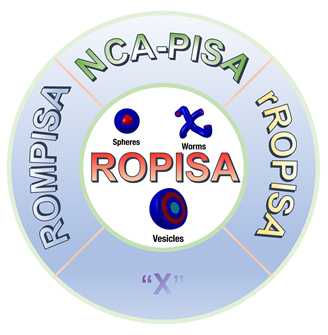摘要/Abstract

聚合诱导自组装(PISA)是一种新兴的纳米粒子制备技术,它集聚合与组装过程于一体,可在高固含量条件下进行,因此备受青睐.此外,通过改变嵌段聚合度以及固含量等参数,可以精确地控制纳米粒子的形貌,实现从球形胶束到空心囊泡的形貌转变.然而,受限于适用于PISA体系的聚合方法和单体种类,其发展也受到了一定的限制.目前,PISA主要基于可逆加成-断裂链转移聚合(RAFT),其在聚合诱导自组装机理、形貌控制、结构表征等方面的研究成果,对于高分子化学其他领域具有重要的参考价值.然而,由于RAFT聚合诱导自组装(RAFT-PISA)体系中适用的单体往往局限于(甲基)丙烯酸酯类和苯乙烯类,导致RAFT-PISA制备的纳米粒子限于其碳-碳主链的基本结构难以生物降解,因此生物医用前景并不乐观.为了克服以上缺陷,开环聚合诱导自组装(ROPISA)应运而生,主要包括开环易位聚合诱导自组装(ROMPISA)、氨基酸-N-羧基-环内酸酐开环聚合诱导自组装(NCA-PISA)及自由基开环聚合诱导自组装(rROPISA).由于ROMPISA体系对诸多功能性基团表现出化学惰性,从而为多功能纳米粒子的原位制备提供了新的方法;而rROPISA和NCA-PISA则使得生物可降解纳米粒子的原位制备成为可能.作为PISA领域崭新的研究方向,ROPISA不仅将新聚合方法引入了PISA体系,而且突破了以往PISA难以制备可降解纳米粒子的瓶颈,为PISA技术在生物医药领域的应用架起了桥梁.作者简要总结了ROPISA的发展现状,着重分析并提出了该领域面临的挑战,最后从机理研究、单体设计及转化应用等方面对ROPISA的发展前景进行了展望.
关键词: 聚合诱导自组装(PISA), 开环聚合诱导自组装(ROPISA), 开环易位聚合诱导自组装(ROMPISA), 氨基酸-N-羧基-环内酸酐开环聚合诱导自组装(NCA-PISA), 自由基开环聚合诱导自组装(rROPISA)
Polymerization-induced self-assembly (PISA) is one of the most cutting-edge strategies towards the preparation of nanoparticles with a range of morphologies (spheres, worms, vesicles, etc.) as it combines polymerization and self-assembly and thus can afford high solid contents in various media. Additionally, nanoparticle morphology can be accurately targeted by adjusting the degree of polymerization of the soluble stabilizer block and the insoluble core-forming block, as well as solid contents in PISA formula. Unfortunately, this highly efficient approach is limited to specific polymerization methods, and hence specific monomer types. Currently, PISA based on reversible addition-fragmentation chain-transfer polymerization (RAFT) has been well-established for the in situ preparation of a range of nanoparticle morphologies. This method is relatively mature especially in the mechanism exploration, morphological control, and characterization, which has important impact to other fields of polymer chemistry. However, methacrylates, acrylates, and styrene monomers are often essential for reversible addition-fragmentation chain-transfer polymerization-induced self-assembly (RAFT-PISA), leading to the carbon-carbon backbone, which normally produces nonbiodegradable structures. These drawbacks are detrimental in terms of biomedical applications. Fortunately, new PISA strategies based on ring-opening polymerizations, including ring-opening metathesis polymerization-induced self-assembly (ROMPISA), ring-opening polymerization of N-carboxy- anhydride-induced self-assembly (NCA-PISA) and radical ring-opening polymerization-induced self-assembly (rROPISA), have been developed to overcome these problems. ROMPISA has proven to be an efficient approach for fabricating multifunctional nanoparticles due to its great tolerance for many functional groups. Biodegradable nanoparticles, including spheres and vesicles, have been successfully prepared by rROPISA and NCA-PISA. Therefore, ring-opening PISA (ROPISA) provides not only new polymerization methods but also new strategies for fabricating biodegradable nanoparticles with a range of monomer species. In this perspective, we briefly summarize the current progress and analyze the challenges of ROPISA. Finally, we provide a perspective for the further development of ROPISA addressed on the mechanism, monomers and applications, which provides an insight into ROPISA as well as some suggestions and directions for its future research.
Key words: polymerization-induced self-assembly (PISA), ring-opening polymerization-induced self-assembly (ROPISA), ring-opening metathesis polymerization-induced self-assembly (ROMPISA), ring-opening polymerization of N-carboxy-anhydride-induced self-assembly (NCA-PISA), radical ring-opening polymerization-induced self-assembly (rROPISA)
PDF全文下载地址:
点我下载PDF
